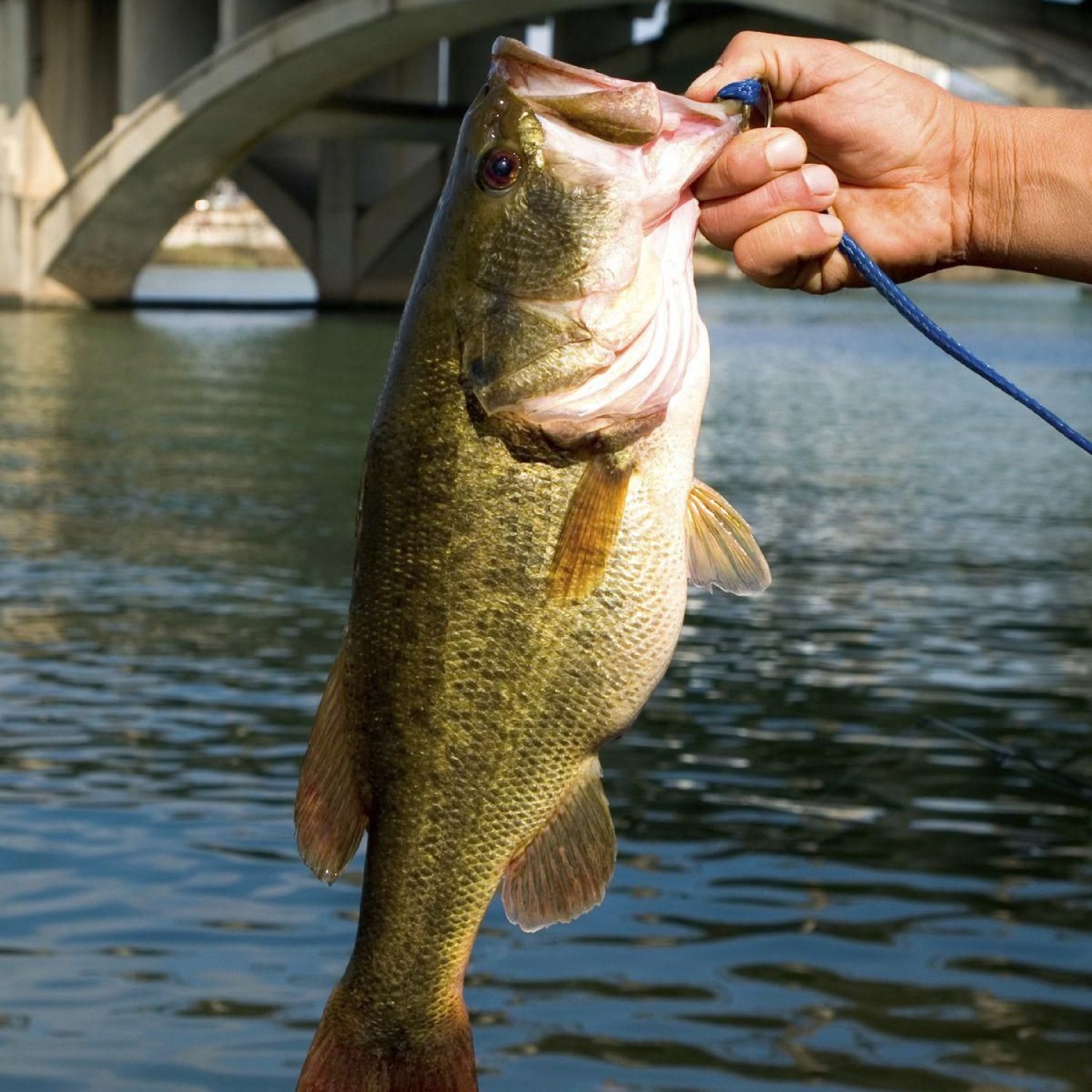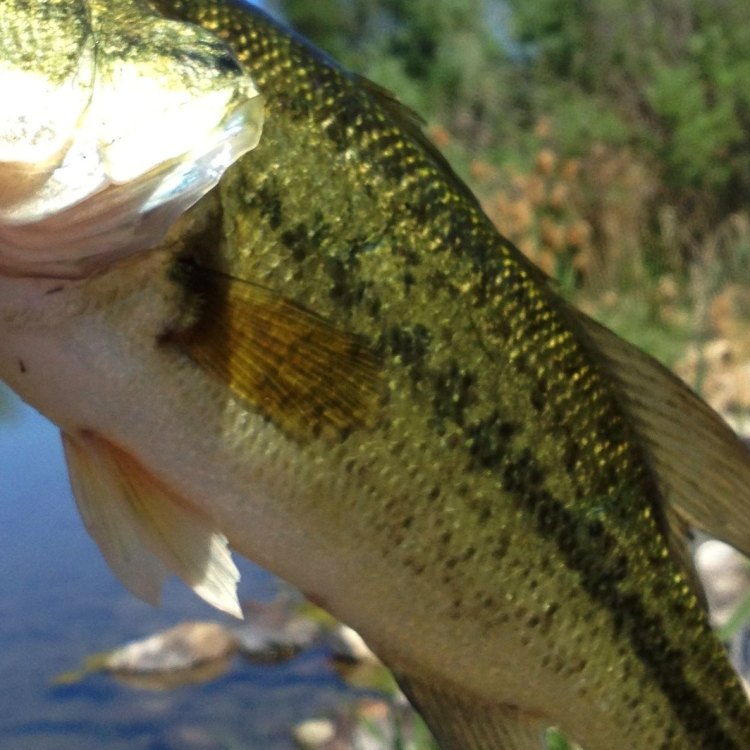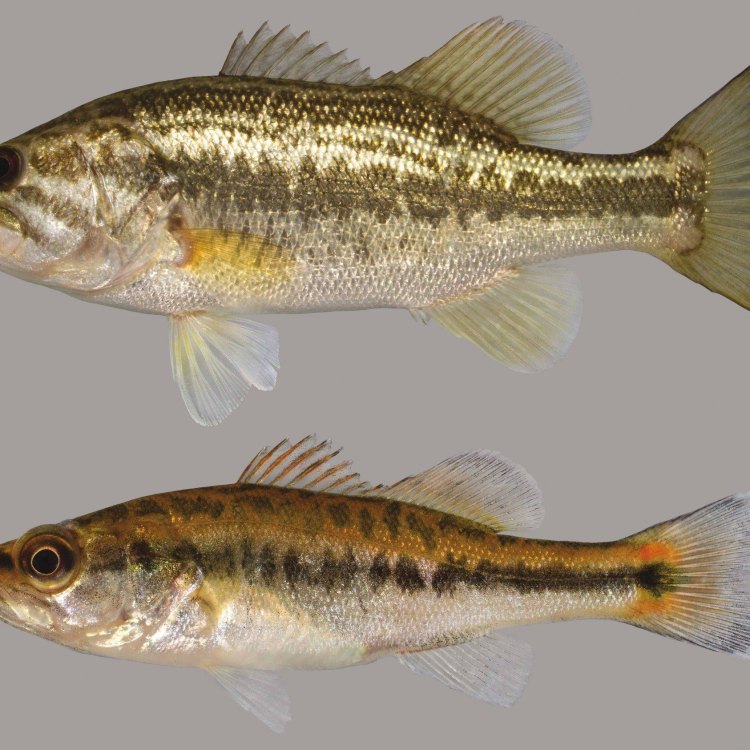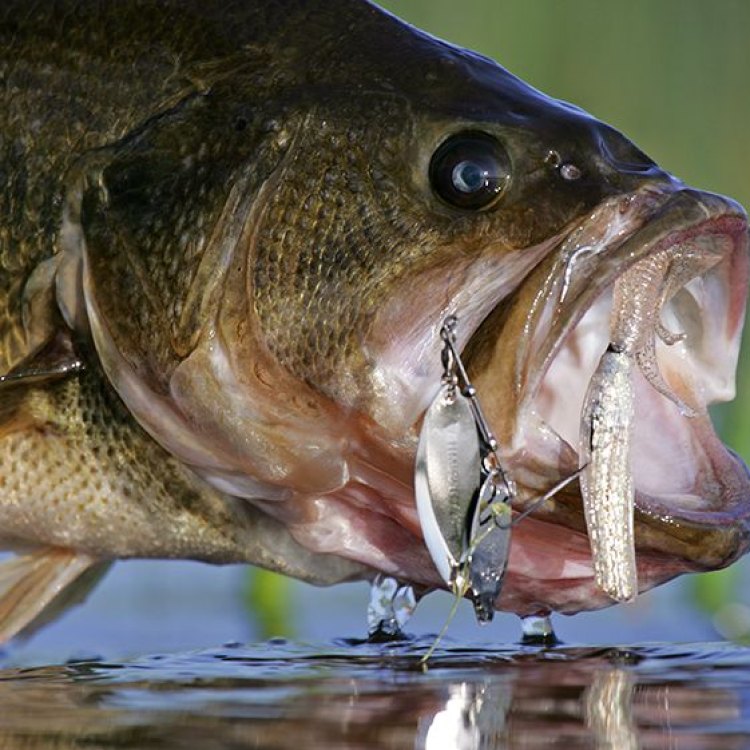
Largemouth Bass
40-80 centimeters
Meet the Largemouth Bass, a popular freshwater fish found in lakes, ponds, rivers, and reservoirs. With a typical length of 40-80 centimeters, these fish are part of the Centrarchidae family and have a slender and elongated body shape. Get ready for an exciting fishing experience with this agile and powerful swimmer! #LargemouthBass #FreshwaterFishing #Wildlife
Animal Details Summary:
Common Name: Largemouth Bass
Kingdom: Animalia
Habitat: Freshwater
The Mighty Largemouth Bass: A Freshwater Predator from America
Welcome to the world of the Largemouth Bass, one of the most sought-after game fish in North America. Also known by its scientific name Micropterus salmoides, this carnivorous fish has captured the hearts and rods of many anglers, both professional and amateur. Its sleek body, sharp teeth, and voracious appetite make it a formidable predator in the freshwater ecosystem. Let's dive deeper into the world of this fascinating fish and discover what makes it a true warrior of the waters Largemouth Bass.A Member of the Centrarchidae Family
The Largemouth Bass belongs to the animal kingdom, phylum Chordata, and class Actinopterygii. It is classified under the order Perciformes, which includes over 41% of all fish species. Perciformes is a diverse group of fish with a range of feeding habits, body shapes, and sizes. The Largemouth Bass is part of the Centrarchidae family, which includes other popular game fish such as Bluegill, Sunfish, and Crappie.The Largemouth Bass: A Freshwater Predator
The Largemouth Bass is found in freshwater ecosystems, including lakes, ponds, rivers, and reservoirs. In its natural habitat, it can grow up to 40-80 centimeters in length and weigh up to 10 kilograms. This makes it one of the largest species in the Centrarchidae family, with the potential to dominate the waters it inhabits.Feeding Method: Carnivorous
As a carnivorous fish, the Largemouth Bass feeds on a diverse diet of fish, frogs, crayfish, and other small aquatic animals. Its elongated body and sharp, needle-like teeth make it a skilled predator, able to strike its prey with incredible precision Llama. The Largemouth Bass is also an opportunistic feeder, taking advantage of any available food sources in its environment.A Native of North America
The Largemouth Bass is native to North America, where it can be found in abundance. Its geographical distribution extends from southern Canada to northern Mexico, covering most of the United States. It thrives in both warm and cool waters, making it a versatile species that can adapt to changing conditions.Appearance: A Master of Camouflage
The Largemouth Bass is known for its distinctive dark green to olive coloration on its back, lighter green or yellow on the sides, and white on the belly. This coloring serves as a perfect camouflage in its freshwater habitat, allowing it to blend in seamlessly with its surroundings. This makes it a skillful ambush predator, able to surprise and catch its unsuspecting prey.Body Shape: Sleek and Elongated
The Largemouth Bass has a sleek and elongated body, which enables it to glide through the water effortlessly. Its streamlined shape allows it to move quickly and with precision, making it a formidable predator. This body shape also helps the Largemouth Bass conserve energy while swimming, making it an efficient hunter.A Popular Game Fish
The Largemouth Bass's ferocity and impressive size make it a highly sought-after game fish. Its popularity among anglers has led to its stocking in various freshwater bodies around the world, including Europe, Africa, and Asia. However, it remains most abundant and sought-after in the United States, where it is a staple in tournaments and fishing expeditions.Fishing Techniques for Largemouth Bass
If you're interested in catching a Largemouth Bass, there are various techniques you can use to increase your chances of a successful catch. These include:- Topwater Fishing – Using lures or baits that float on the water's surface to entice the fish to strike.
- Spinnerbait Fishing – Using a spinnerbait with metal blades to imitate a small fish, attracting the Largemouth Bass to strike.
- Jig Fishing – Using a weighted hook or jig with a soft plastic bait or live bait to mimic a swimming prey, triggering the fish's feeding instinct.
- Crankbait Fishing – Using a crankbait with a diving lip to create a wobbling and diving movement that resembles an injured fish, enticing the Largemouth Bass to strike.
- Fly Fishing – Using specialized flies to mimic a variety of insects and creating a natural-looking prey for the fish.
Fishing Regulations and Conservation Efforts
With the increasing popularity of Largemouth Bass fishing, there have been concerns about overfishing and depleting populations. As a result, many states have implemented fishing regulations to ensure sustainable harvesting of this game fish. These regulations include size and bag limits, as well as catch and release policies. Furthermore, many conservation efforts are in place to protect the Largemouth Bass's natural habitat and breeding grounds, ensuring its population remains healthy and thriving.The Largemouth Bass in Culture and Cuisine
Aside from its popularity among anglers, the Largemouth Bass also holds a special place in American culture. It is often featured in art, literature, and music, depicting its strength and ferocity as a game fish. It is also a significant part of traditional Southern cuisine, where it is typically deep-fried or grilled and served with various dishes. However, with conservation efforts in place, it is essential to follow fishing regulations and practice sustainable fishing methods to ensure the Largemouth Bass population remains stable.In Conclusion
The Largemouth Bass is a true warrior of the waters, dominating its freshwater habitat and capturing the hearts and rods of countless anglers. Its unique characteristics, from its body shape and coloration to its feeding habits, make it an incredibly fascinating and highly sought-after species. As we continue to study and appreciate the Largemouth Bass, let us also work towards preserving its natural habitat and ensuring its population remains healthy for generations to come.

Largemouth Bass
Animal Details Largemouth Bass - Scientific Name: Micropterus salmoides
- Category: Animals L
- Scientific Name: Micropterus salmoides
- Common Name: Largemouth Bass
- Kingdom: Animalia
- Phylum: Chordata
- Class: Actinopterygii
- Order: Perciformes
- Family: Centrarchidae
- Habitat: Freshwater
- Feeding Method: Carnivorous
- Geographical Distribution: North America
- Country of Origin: United States
- Location: Lakes, ponds, rivers, and reservoirs
- Animal Coloration: Dark green to olive on the back, lighter green or yellow on the sides, and white on the belly
- Body Shape: Slender and elongated
- Length: 40-80 centimeters

Largemouth Bass
- Adult Size: Up to 10 pounds
- Average Lifespan: 10-16 years
- Reproduction: Sexual
- Reproductive Behavior: Nest-building and guarding eggs
- Sound or Call: Grunting or croaking sound
- Migration Pattern: Seasonal movements within their home range
- Social Groups: Solitary
- Behavior: Ambush predator
- Threats: Habitat loss, pollution, overfishing
- Conservation Status: Least Concern
- Impact on Ecosystem: Ecologically important as both predators and prey
- Human Use: Sport fishing
- Distinctive Features: Large mouth, dark lateral stripe
- Interesting Facts: Largemouth bass are popular game fish in North America and are known for their aggressive feeding behavior. They are able to consume prey up to half their own length. They have the ability to change their coloration based on their environment.
- Predator: Largemouth bass are apex predators in their habitat.

Micropterus salmoides
The Mighty Largemouth Bass: A Master of Ambush in the Aquatic World
When it comes to the world of sport fishing, one species that stands out among the rest is the largemouth bass. This freshwater fish, also known as the black bass, is a favorite among anglers for its aggressive nature and impressive size. But there is much more to this fish than meets the eye. From its unique features and behaviors to its significant impact on the ecosystem, the largemouth bass is truly a fascinating creature worth exploring PeaceOfAnimals.Com.Found in lakes, ponds, and rivers throughout North America, the largemouth bass is a member of the sunfish family. It is the largest of all the black bass species, with adult individuals reaching up to 10 pounds in weight and a length of over 2 feet. Despite their large size, largemouth bass have an average lifespan of only 10-16 years in the wild, with some individuals living up to 20 years.
But what sets the largemouth bass apart from other fish species? Let’s dive a little deeper into their unique characteristics and behaviors.
The Circle of Life: Reproduction and Reproductive Behavior
Like most fish, the largemouth bass reproduces through sexual reproduction. This process takes place during the spring and early summer when the water temperature reaches around 60-65 degrees Fahrenheit. During this time, male largemouth bass prepare nest sites, typically in shallow water, by clearing gravel or debris from the sediment. Once the nest is ready, the male will attract a female by displaying courtship behaviors, such as swimming in circles and nudging her with his head.Once the female enters the nest, she will deposit eggs while the male releases sperm to fertilize them Loach. The female can lay up to 7,000 eggs, which are then guarded and aerated by the male until they hatch in about a week. During this time, the male remains extremely protective and will chase away any fish that comes near the nest. This nest-building and egg-guarding behavior makes the largemouth bass a unique and dedicated parent in the fish world.
The Sounds of the Largemouth Bass
While fish are not known for their vocalizations, the largemouth bass is an exception. This fish has the ability to produce a low grunting or croaking sound, mostly by vibrating its swim bladder. This sound is believed to play a role in courtship and territorial defense, with males using it to attract females and to defend their territory from other males. So, next time you’re out fishing for largemouth bass, listen closely, and you might just hear these unique sounds.Seasonal Movements and Social Groups
Unlike some fish species that migrate long distances, largemouth bass have more of a homebody nature. They are known to have seasonal movements within their home range, which may be a few miles in size. During the colder months, they tend to stay in deeper waters, while in the warmer months, they move closer to shore and into tributaries to spawn.As for their social life, largemouth bass are mostly solitary fish. They are not known to form groups or shoals, except during spawning when they congregate in pairs. However, they do have a hierarchy within their social structure, with larger and more dominant individuals occupying and defending the best habitats for hunting and breeding.
Ambush Predators: The Hunting Behavior of Largemouth Bass
One of the most intriguing and well-known behaviors of the largemouth bass is its hunting style. These fish are ambush predators, meaning they hide and wait for their prey to come within striking distance. They have a keen sense of smell and can detect vibrations in the water caused by potential prey.Once a potential meal is spotted, the largemouth bass will quickly swim towards it and grab it in its large, protruding mouth. They are capable of consuming prey up to half their own length, making them a formidable predator in their habitat. These ambush tactics, combined with their strong jaw and sharp teeth, make the largemouth bass a feared hunter in the aquatic world.
Risks and Threats: Conservation Status of Largemouth Bass
Like many other species, the largemouth bass faces multiple threats in the wild. One of the biggest risks to their survival is habitat loss and degradation. As humans continue to develop and expand into natural areas, the habitats of these fish are being destroyed, leaving them with less space to thrive.Pollution is another major threat to the largemouth bass. As water bodies become contaminated with agricultural runoff, industrial waste, and garbage, the quality of their habitat declines, making it difficult for fish to survive. Overfishing is also a concern, as recreational and commercial fishing can deplete populations if not properly regulated.
Despite these risks, the International Union for Conservation of Nature (IUCN) classifies the largemouth bass as a species of Least Concern. This is good news, but continued efforts are necessary to ensure their populations remain stable.
Ecological Importance and Human Use
Apart from being a popular game fish, largemouth bass play a crucial role in the ecosystem. As ambush predators, they help control the populations of smaller fish and invertebrates, preventing their numbers from getting out of hand. This is important in maintaining the balance in the aquatic food chain.Largemouth bass are also a significant source of recreation, with millions of people worldwide participating in sport fishing for this species. However, it is essential to ensure sustainable fishing practices are in place so that the largemouth bass populations can continue to thrive for years to come.
Distinctive Features and Interesting Facts
One look at the largemouth bass, and you’ll immediately notice its large mouth, a feature that gives this fish its name. Their mouths can stretch wide, allowing them to consume prey larger than many other fish species. Another distinctive feature is the dark lateral stripe that runs along their sides. This stripe is believed to help them blend in with their surroundings and protect them from predators.But perhaps the most interesting fact about the largemouth bass is its ability to change its coloration depending on its environment. This unique adaptive feature allows them to better camouflage and hide from predators, making them even more skilled hunters.
The Apex Predator of the Aquatic World
Largemouth bass may not seem like apex predators at first glance, but in their habitat, they are indeed at the top of the food chain. Thanks to their unique features and behaviors, these fish have mastered the art of ambush and are well-suited for survival in the wild. However, as humans continue to have an impact on their habitats, it is essential to protect and preserve these fascinating creatures to maintain the balance of our aquatic ecosystems. So, the next time you come across a largemouth bass, take a moment to appreciate the many incredible qualities of this remarkable fish.

The Mighty Largemouth Bass: A Freshwater Predator from America
Disclaimer: The content provided is for informational purposes only. We cannot guarantee the accuracy of the information on this page 100%. All information provided here may change without prior notice.












